|
Trams in Kolkata
The Kolkata Tram System, is a tram system that serves Kolkata, the capital city of the Indian state of West Bengal, operated by West Bengal Transport Corporation (WBTC) after Calcutta Tramways Company (CTC) was merged with WBTC. Being started in 1873 Kolkata tram is the second oldest operating tram network in the world after Turin (1871). Being electrified in 1902, Calcutta became the first Asian City with electric tramway.[4] The Kolkata Tram is the only tram system operating now in India. With the help of periodic negligence, the Government of West Bengal (current operators) had formed systematic initiatives to suspend the entire tram network from the city and sell properties. However, an apolitical organization named Calcutta Tram Users Association (CTUA) was formed in 2016 to advocate in favor of Kolkata's tram system.[5] The network initially had up to 37 lines in the 1960s,[6] but has gradually reduced over the years with only two lines currently operating due to financial struggles, poor maintenance, low ridership, addition of road flyovers, expansion of the Kolkata Metro, slow tram speed and perceptions that the trams are outdated and occupy too much road space. There are currently two tram routes running which are route 5 (Esplanade - Shyambazar) and route 25 (Gariahat - Esplanade). History1873–1901: Horse-drawn trams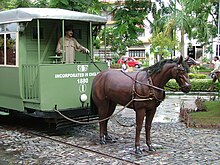 The first horse-drawn trams in India ran for 2.4 miles (3.9 km) between Sealdah and Armenian Ghat Street on 24 February 1873. The service was discontinued on 20 November of that year.[2] The Calcutta Tramway Company was formed and registered in London on 22 December 1880. Meter-gauge horse-drawn tram tracks were laid from Sealdah to Armenian Ghat via Bowbazar Street, Dalhousie Square, and Strand Road. The route was inaugurated by the Viceroy, Lord Ripon, on 1 November 1880.[2]    At first, it was planned to open tram network in three directions – in north towards Kumartuli via Chitpur Road (now Rabindra Sarani) for easy transportation of then-rich Indians, middle-classes and poor who lived in those areas, in the east towards Sealdah stations via Bowbazar Street (now Bipin Bihari Gangopadhay Street) for railway passengers' interchange who come from outside of Kolkata, and in the south towards Kalighat via Russa Road (now Ashutosh Mukhopadhyay Road) because not only for easy transportation of then-rich Indians, middle-classes and poor who lived at those areas but also as a Hindu pilgrimage regarding Kali temple for inhabitants and tourists. Kalighat tram depot was also constructed at that, time, which was also a minor workshop for all horse trams. Besides this the city center connection between Dharmatala (now known as Esplanade) & Dalhousie Square (now known as Binay Badal Dinesh Bag) was also established via Old Court House Street (now Hemanta Basu Sarani).[7] One year later, a second route towards north Kolkata up to Shyambazar via College Street was opened for residents and students of medical college, university, and various schools & colleges. A second route from Wellington Square (now known as Subodh Chandra Mullick Square) to Sealdah Station via Moula Ali was also opened for more transportation of railway passengers. Sealdah tram terminus was at that place where Sealdah metro station of the Kolkata metro line 2 is. At the same time, the first opening a westward tram route was opened by the High Court via Strand Road (now Rajib Gandhi Sarani) was connected by tram network for pleaders, law-related peoples, and river-bathers of Ganga. High Court tram terminus was at that place where now the annexure building of the High Court is situated. Another connection from Metcalf Hall towards Nimtala via Strand Road (now Rajib Gandhi Sarani) was also opened for serving the crematorium and serving of businessmen. Nimtala tram terminus was at that place beside of the red temple building is now situated.[7] By opening those routes, Shyambazar, High Court, Nimtala, Sealdah, Dalhousie Square, Dharmatala and Kalighat area was connected by horse tram. Kalighat was the only depot at that time, so it was the oldest tram depot. Timeline
1883–1902: Steam tramsIn 1882, steam locomotives were deployed experimentally to haul tram cars. In the next year a new route opened for steam tram service towards Khidirpur. Tram tracks were laid down via Dufferin Road through maidan, and on reserved track for high-speed steam trams for morning walkers, tourists, race-course goers, and peoples living on those area. Khidirpur tram depot was also constructed at that time, which was also a minor workshop for all steam trams.[7] It was followed by a south-central branch towards from Wellington Square to Park Street (now Mother Teresa Sarani) via Wellesley Street (now Rafi Ahmed Kidwai Road).[7] After a long sixteen years gap, the Nimtala route was connected with Company Bagan line via Nimtala Ghat Street, and the Dharmatala – Nimtala service was changed to steam tram. At this time horse trams ran on Shyambazar, Sealdah, High Court & Kalighat routes, and steam trams ran on Nimtala, Park Street & Khidirpur route. The Dharmatala – Wellington Square section and Esplanade – Metcalfe Hall section, were served by both horse and steam trams until 1901. Khidirpur & Kalighat were the only steam & horse tram depot at that time respectively. By the end of the century, the company owned 166 tram cars, 1,000 horses, seven steam locomotives, and 19 miles of track.[2] Timeline
1902–1951: Electric trams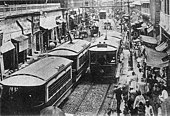 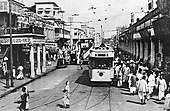 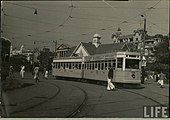   In 1900, the electrification of the tramway and conversion of its tracks to 4 ft 8+1⁄2 in (1,435 mm) (standard gauge) began.[2] The first electric tramcar in Calcutta ran from Esplanade to Kidderpore on 27 March 1902, with service from Esplanade to Kalighat introduced on 14 June of that year. Both Kalighat & Khidirpur tram depot was converted to electric tram depot. The connecting route through Grey Street (now Arabinda Sarani) was opened in that year for a second route between Shyambazar and Dharmatala. The Nonapukur Workshop was established also in that year, from where the track connection up to Wellesley Street opened via Elliott Road, after which the Park Street branch closed. Now the major repairing of the horse, steam and electric trams was started at Nonapukur.[7] In next year, the Kalighat line was extended to Tollygunge for serving the then south suburban area and film studios via Russa Road (now Shyama Prasad Mukhopadhyay Road). Tollygunge tram depot was also constructed at that time, which was the largest tram depot in terms of area. The Shyambazar line was also extended to Belgachia for serving the then north suburban area, hospital, and rail yards via Belgachhia Road (now Radha Gobinda Kar Road). Belgachhia tram depot and Shyambazar tram terminus were also opened in this year.[7] In next year, The Kumourtuli line was extended to Bagbazar, after which the Kumortuli terminus was closed. Bagbazar tram terminus was at that place where now a lorry parking area beside the circular railway track.[7] A new route from Sealdah Station to Howrah Bridge (now Rabindra Setu) via Harrison Road (now Mahatma Gandhi Road) was opened on next year, for serving the businessmen, residents, ferry passengers and railway passengers for Howrah Station. At that time the electrification project was completed.[2]   Two years later, the connection between Nonapukur and Moula Ali opened via Circular Road (now Acharya Jagadish Chandra Basu Road), and after that tram service started from Nonapukur to Howrah Bridge via Sealdah station. A branch up to Mominpur was also opened from Wattganj via Diamond Harbour Road, but at that time direct access was constructed through Orphanganjbazar.[7] In next year a new branch was constructed from Shyambazar Junction to Galiff Street via Cornwallis Street (now Bidhan Sarani), and occasional tram service was also started from Galiff Street to Dharmatala. Side by side the Mominpur branch was also extended up to Behala, another then south suburban area via Diamond Harbour Road (now Balananda Brahmachari Sarani). At that time Behala tram terminus was at right side of Diamond Harbour Road. The connecting route through Alipur Road was also opened in that year for a tram connection between Behala & Kalighat, also a second route between Kalighat and Dharmatala.[7] At that time, tram service was opened in Howrah City. From Howrah Station, two routes were selected. One towards north up to Bandhaghat via Dobson Road (Now Moulana Abul Kalam Azad Road), another towards south up to Shibpur via Grand Trunk Road. For shibpur route, a single coach double-ended tram was selected due to the lack of creating a loop at Shibpur. For Howrah service, a new depot was constructed at Ghasbagan. Hence then the old Howrah Bridge was a pontoon bridge, it was not possible to connect Kolkata tram and Howrah tram directly.[7]  Two years later, the Sealdah Station to Rajabazar route opened in 1910. Rajabazar tram depot was also constructed at that time, which was the largest tram depot in terms of track number.[7]  After a long 15 years gap, new tram route construction had started again in 1925. The Nonapukur line was extended to Park Circus via Park Street (now Mother Teresa Sarani) for serving residents and circus goers of that area. Park Circus tram depot was also constructed at that time. In the next year, the direct access of the Behala line via Orphanganjbazar was replaced by present alignment via Wattganj junction for smooth tram service.[7] A new terminus near Racecourse was constructed in next year for race special trams towards Belgachhia, Bagbazar, Galiff Street, Rajabazar, High Court, Nimtala, Park Circus, Tollygunge, Behala & Khidirpur. In the next year, a new branch was constructed from Kalighat to Ballygunge, another then south suburb of Kolkata via Ballygunge Avenue (now Rasbihari Avenue).[7]   After again a long 13 years gap, new tram route construction had started again in 1941. The Rajabazar line was extended to connect with Galiff Street line at Shyambazar junction via Circular Road (now Acharya Praphulla Chandra Ray Road).[7] Two years later, when new Howrah Bridge (now Rabindra Setu) was opened, tram service started crossing the river Hooghly and connecting Kolkata & Howrah tram network. Very few times trams from Shibpur and Bandhaghat came towards Dharmatala and Rajabazar. In the same year, the Park Circus line was extended to connect with the Ballygunge line at Gariahat junction via Gariahat Road (now Syed Amir Ali Avenue). Gariahat tram depot was also constructed at that time.[7] With this extension, total track length reached 42.0 miles (67.59 km).[2] 1951–1990: NationalisationIn 1951, the government of West Bengal entered an agreement with the Calcutta Tramways Company, and the Calcutta Tramways Act of 1951 was enacted. The government assumed the tramways, reserving the right to purchase the system with two years' notice on 1 January 1972 or at any time thereafter.[2] After Independence, during the partition of India, the number of people started dramatically increasing on the roads of Kolkata due to a lot of refugees. The city centre area started getting congested due to the increasing number of buses and cars. So tram company thought to shift the tram tracks of Dalhousie Square from outside to the inside of the square. It was completed in 1952.[7] It was followed by redesigning of Esplanade terminus in 1960, also due to increasing number of pedestrians and automobiles. At that time, there were five ways of tram routes from Esplanade, i.e. – Bentinck Street, Dharmatala Street (now Lenin Sarani), Chowrangi Road (now Jawaharlal Nehru Road), Dufferin Road and Old Court House Street (now Hemanta Basu Sarani), and three ways of tram routes from Dalhousie Square, i.e. – Old Court House Street (now Hemanta Basu Sarani), Hare Street & Lalbazar Street.[7] Four years later, the old Majherhat bridge was replaced by a new bridge with tram tracks.[7] The Calcutta Metropolitan Planning Organisation (CMPO) introduced a plan in 1964 for a new network in the philosophy of the semi-metro called "Aerorail". Light rail vehicles would make use of viaducts in the city centre on two axis. These vehicles were to be compatible with the existing tram system, and the viaducts would have been built in stages. The plan was shelved because of opposition, expecting unforeseen difficulties.[8] In 1967, the Government of West Bengal passed the Calcutta Tramways Company (Taking Over of Management) Act and assumed management on 19 July. Until that time, it was the golden age of Kolkata, with maximum number of rolling stocks, route kilometers and passengers. Some 415 trams were in daily service, out of a total of 459.[9] Decline The decline of tram networks started in India during the early thirties, when the Kanpur tram was closed. However other cities had continued trams, but mass closure started from the mid-fifties to mid-sixties, when tram networks of Chennai, Delhi, and Mumbai gradually closed. Overall in the world, at that time, trams were thought of as an old technology and inflexible. The number of automobiles was increasing, so it started occupying tram tracks especially on narrow streets, and tram services got hampered. But surprisingly, car and bus drivers started blaming the tram, which was fueled by political leaders. So it was decided to close the entire Kolkata tram network within 1980. On 8 November 1976, the Calcutta Tramways (Acquisition of Undertaking) ordinance was promulgated under which the company (and its assets) was nationalized.[2]    The Howrah sections were decided to close first, because the government thought trams were creating traffic jams on narrow streets of Howrah city. So in 1971, both the Bandhaghat and Shibpur lines were closed, including the Ghasbagan tram depot. The depot got vacant and abandoned for some vehicle dumping place. However the Howrah station terminus survived, but it was started redesigning largely. All single and double coach trams were transferred to Kolkata area. In Kolkata, a new tram terminus was constructed in Behala, this time on the left side of Diamond Harbour Road for no need for reversing the tram.[7] Two years later, Nimtala route along Companybagan (now Rabindra Kanan) section was closed in May 1973, and the Howrah Station terminus redesigning completed in 1976. The racecourse terminus was also closed due to the construction of 2nd Hooghly Bridge (now Vidyasagar Setu).[7] Total track length was now reduced to 38 miles (61.2 km).[2]  However, tram service was survived in Kolkata, largely supported by then transport minister Rabin Mukherjee, and also due to high rise of oil prices in the international market, which make costly for automobiles. Internationally some cities were started returning tram for this economical reason. Since 1978, line 1 of Kolkata metro construction was started by the cut & cover method. It was needed the construction of a large trench through the planned route, which was mostly served before by tram. So it was thought to temporarily close the tram service along those routes. Later it was planned to part of the tram routes in south Kolkata would remain opened because two tram depots - Kalighat & Tollygunge were situated along the tram route, and it was not practical to close those depots and close a number of tram routes for this reason, rather thought to diverse some tram routes. For this reason, tram tracks between Hazra Park (then renamed to Jatin Das Park) and Dharmatala (then renamed to Esplanade) via Planetarium was closed (the 3rd oldest tram route), but all tram routes which were running via Ashutosh Mukhopadhyay Road and Jawaharlal Nehru Road were diverted via Biplabi Ganesh Ghosh Sarani, Alipur Road, Diamond Harbour Road, Khidirpur Road & Dufferin Road. This closed section was partially reopened in the next year between Planetarium and Esplanade due to protests of passengers, tourists, and hawkers. A new terminus was constructed beside Birla Planetarium.[7] At that time, construction of Sealdah Flyover was started. Due to its low height (for running tram on it), it was decided to close tracks between Sealdah and Lebutala, but diverse this route from Lebutala to Mirzapur via Raja Ram Mohan Sarani & Surya Sen Street. In the 1st phase, tram service opened between Mirzapur and Purabi cinema for Howrah Station tram routes, and in the next year from Purabi Cinema to Lebutala for Binay Badal Dinesh Bag routes. At that time Surya Sen Street was the only tram only street of Kolkata, and the original route previously mentioned (the oldest tram route) with Sealdah Station terminus was closed.[7] For metro line 1 construction, the tracks between Lalbazar and Esplanade via Bentinck Street (the 2nd oldest tram route) was also closed, but all tram routes which were running via Bentinck Street were diverted via Hemanta Basu Sarani & Lalbazar Street.[7] In next year, Sealdah flyover opened with tram tracks on it. It was very few flyovers of the world which had tram tracks.[7] ExpansionAfter a one decade major closures of the lines, some new routes were planned by government. Then transport minister Rabin Mukherjee proposed some new lines and connecting lines. Those were –
For first phase, first two lines were selected. On 17 April 1985, tracks were extended 3.7 km (2.30 mi) from Maniktala to Ultadanga via Maniktala Main Road (now Satin Sen Sarani) and C. I. T. Road.[7] (now Acharya Satyendra Nath Basu Sarani).[2] This route was selected for expanding the Kolkata towards east. At first it was planned that there will be two branches, one to Bidhannagar (Karunamayi), another to Airport. However, residents of Bidhanngar were highly against of tram, so that extension was finally cancelled. The Airport extension was also cancelled later. On 31 December 1986, the route extension from Behala to Joka was completed via Diamond Harbour Road.[2] It was the first and only village extension of Kolkata tram network, for developing this area as a city. After opening this line, it was the longest tram route of Kolkata.[7] Unfortunately, this opening created some controversy. The then transport minister Rabin Mukherjee was an MLA of Behala (West), where this route passed. When it was opened, it broke the election code of conduct, and so he was suspended from the post of transport minister before the election. He was a strong supporter of tram, and after his suspension, when new transport minister Shyamal Chakraborty joined, fast declining of Kolkata tram was started again after some years. All the remaining plans were also cancelled at that time. Timeline
1990–present: Later developments and mass closures   Since 1990, losses of Kolkata tram started increasing, and to overcome this, it was thought by government that the entire tram network will be gradually replaced by bus, and lands of depot and terminus will be sold to promoters for construction of high-rise buildings. Calcutta Tramways Company introduced the bus service on 4 November 1992 with a fleet of 40 buses.[2] The Planetarium line was closed due to excuse of loss making. The terminus was converted to park, however tracks were still present until 2010, and masts are still present, now are being used by lamp posts.[7] After two years, The Howrah Station terminus closed, converted to bus terminus and the tram tracks were removed on Rabindra Setu the following year, since the world's busiest ageing cantilever bridge was not strong enough for trams. The routes which terminated there were moved back to the Burrabazar (Howrah Bridge) terminus (formerly Burrabazar Junction). Tram tracks from Howrah Bridge terminus to Metcalf Hall was also closed due to excuse of road repair, and all routes which were served this section was now diverted via Rabindra Sarani. However, in this year a new terminus in Ultadanga opened near Railway Station.[7] The system had degraded by the 1990s, and Minister for Transport Shyamal Chakraborty planned to close the network. In 1995, the High Court terminus closed for the reconstruction of Strand Road. Rails and wires were removed from there and from Strand Road, Hare Street, and Shahid Khudiram Basu Road and it is now the site of the newest Kolkata High Court centenary building.[7] However, Melbourne tram conductor Roberto D'Andrea befriended fellow Calcutta conductors during a 1994 visit. When D'Andrea heard about the planned network closure, he suggested an art project to decorate the trams (as was done in his home city). The project increased public awareness of the network and its value, ultimately saving it at that time.[10] However closures were continued. In 1998, the Gariahat Depot–Gariahat Junction link on Lila Roy Sarani closed for construction of the Gariahat overpass.[11] It was early planned to relaying tram tracks on two sides of the road under the overpass, but it was finally cancelled because of then Mayor Subrata Mukherjee. During his reign, tram network again got on threat of closure, because he was a strong anti-tram person. Four years later, the Mominpur–Behala route on Diamond Harbour Road closed for the construction of an overpass in Taratala.[7] Although it was initially planned to relaying tracks on the overpass after its completion, the road was later converted to a national highway and the plan was dismissed. Mass ConcretizationIn 2004, state government decided to deserved all grass-bed reserved tracks from tram only operation, and replace it by concrete bed. Cobblestone bed tracks were also planned to replacing by concrete bed. For this reason, Shayambazar to Galiff Street section was closed, and modification of Shyambazar junction done by now tram service could continue from Rajabazar to Belgachia instead of Galiff Street. Rails and overhead lines were removed from part of the Bidhan Sarani route. In 2008, Binay Badal Dinesh Bag terminus was largely redesigned for construction of underground car parking.[7]  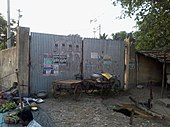  Since 2011, line 3 of Kolkata metro construction was started by elevated method. It was needed construction of pillars through the planned route from Majherhat to Joka, which was mostly served before by tram. So the Behala-Joka route closed for construction of the metro line 3. In next year, Bagbazar terminus was closed, due to a legal dispute, and the non-revenue section between Bagbazar and Galiff Street became regular route, and double tracked. Galiff Street Terminus was realigned, irregular service from Bagbazar to Galiff Street became regular service. The Lalbazar-Mirzapur down line was closed, but the up line remained.[7] In 2013, 'Charoibeti' and 'Rupasi Bangla', two AC trams, were manufactured at the Nonapukur workshop for heritage tours only.[12] A regular AC tram route would not start until 6 years later. On 30 September 2014, a tram, converted into a museum (Smaranika) in Esplanade, was opened to the public.[13] The Park Circus Depot closed for construction of the Maa Flyover in 2015 and the Nonapukur Depot/Workshop has started regular service; the Gariahat Depot remained.[7] The following year, the Ballygunge Station Depot next to Gariahat Mall also reopened and thus Kalighat/Rashbehari-Ballygunge Station stretch (via Gariahat) became active after 12 years.     After the starting of the line 2 of Kolkata metro in 2017, all the Binay Badal Dinesh Bag bound tram routes have been closed for an indefinite time. Thus tram-plying along Sealdah (Purabi Cinema) Junction-Bowbazar Junction-Lalbazar Junction-BBD Bag, Galiff Street-Sovabazar Junction-Chitpur Junction-Lalbazar Junction, and Hatibagan Junction-Sovabazar Junction stretches has been stopped. The Wattgunge junction to Kalighat/Rashbehari Junction stretch has also been closed for an indefinite time since 2018, due to the Majherhat Bridge collapse and thus Tollygunge to Ballygunge Station bound tram route becomes an isolated one. In 2019, it was decided by All India Trinamool Congress government that no any tram service would be continued over any bridge, because tram could reduce the lifespan of bridges. After the decision of mayor Firhad Hakim and transport minister Shubhendu Adhikari, tram service was closed on Belgachia Bridge, Shyambazar Bridge, Maniktala Bridge, Kalighat Bridge & Sealdah Overpass. The tram trackbed renewal program became unfinished on Belgachia Bridge and Sealdah Overpass, and starting of tram track uprooting started on those bridges. Belgachia tram depot also has been converted to bus depot, despite the track renewal program inside the depot was just completed two months earlier, and thus tram-plying along Maniktala Junction-Shyambazar Junction-Belgachia and Shyambazar Tram Terminus-Shyambazar Junction stretches was closed in 2018.[14] In 2019, first A.C. tram route (AC-1) of Kolkata starts which runs between Esplanade and Shyambazar.[12] The state government decided to stop tram-plying on the 37 years old Sealdah Flyover (Vidyapati Setu), after the survey of the bridge-advisory committee officers in 2019 and thus tram-plying along the Mirzapur-Nonapukur, Purabi Cinema-Sealdah and Moulali-Subodh Chandra Mallik Square stretches has also been stopped.[15][16] State Government also decided to shut down tram-plying on Belgachia Bridge permanently due to the excessive load on the bridge.[17] In a press conference held in December 2023, the mayor Firhad Hakim has stated his intent to close down all the tram routes in the city except Route 36, which would be run as a truncated heritage line till Victoria Memorial. As of November 2024, the work is ongoing. Timeline
Rolling stock  CTC owns 257 trams (as of Sep. 2024), of which 125 used to run daily till 2011.[3] Each single-deck articulated car can carry 200 passengers (60 seated). But the number of trams sharply decreased due to government's negligence and now only 17 trams run daily (as of Sep. 2024). The early horse-drawn cars and steel cars manufactured before 1952 were imported from England. Early trams were single-coach, similar to those in Delhi, Mumbai, Chennai and Kanpur. Triple-coach trams were tried without success. The later stock was the SLT type: double-coach with three doors, four wheels under each coach and no wheels between coaches. SLT trams had no front iron net but had a front-coach trolley pole. The both-end type had a front iron net and a rear-coach trolley pole. These were gradually replaced by articulated trams on all routes. The SLC type was introduced much later on the Bandhaghat line, and continued until its closure in 1971; after that, SLC trams began running on the Gariahat and Tollygunge lines on the Kolkata side. Two trams were recently renovated with front and back glass, fluorescent lights, FM radio, digital display boards, angled seats, and a fibreglass ceiling. The Nonapukur workshop began manufacturing 19 new trams from 2008 to 2010, of which four were nearing completion. The roof is clear polycarbonate sheeting with a wide window, and it has comfortable seating and better visibility from within. The workshop is also renovating steel-body (BSCL) cars. With plans for banquet-cafeteria[18] and air-conditioned trams to attract commuters and foreign tourists (increasing CTC revenue), a single-coach, air-conditioned banquet tram has been introduced for heritage tours of North Kolkata in the morning and South Kolkata in the evening.[19] Although the air-conditioned tram had poor ridership when it was introduced,[20] more air-conditioned trams have since been introduced.[3] These include a tram restaurant (Victoria)[21] and the world's first shopping (glam) tram[22] and library tram.[23] Rolling stock classification

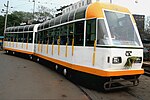
Power supplyThe trams have a 550 V DC power supply from overhead lines. Power was obtained from a trolley pole, a current collector mounted on top of the tram. The track rails were the return path for the current. DC power was supplied by mercury-arc rectifier (converter) stations, located throughout the city. Workshops, Depots and terminiWorkshopKolkata Tram system has a central workshop at Nonapukur, kolkata, referred to as Nonapukur Workshop, which makes tram components and assemble, repair, service, refurbrish trams. The workshop can also produce brand new trams.[26] Tram Depots
Terminus
RoutesActive Routes
Suspended Routes
Defunct RoutesAccidents
Present-day advocacy and awarenessCalcutta Tram Users Association (CTUA) is an apolitical organization created in December 2016 and registered under the Society Act, formed by tramway users and advocating for the tramways of Kolkata since 2016.[34][35] In popular cultureSeveral movies have been shot on the Kolkata tram network and in its depots:[26]
See alsoReferences
Further reading
External linksWikimedia Commons has media related to Trams in Kolkata.
|
|||||||||||||||||||||||||||||||||||||||||||||||||||||||||||||||||||||||||||

